More about less: A New Shorthand Targum Manuscript
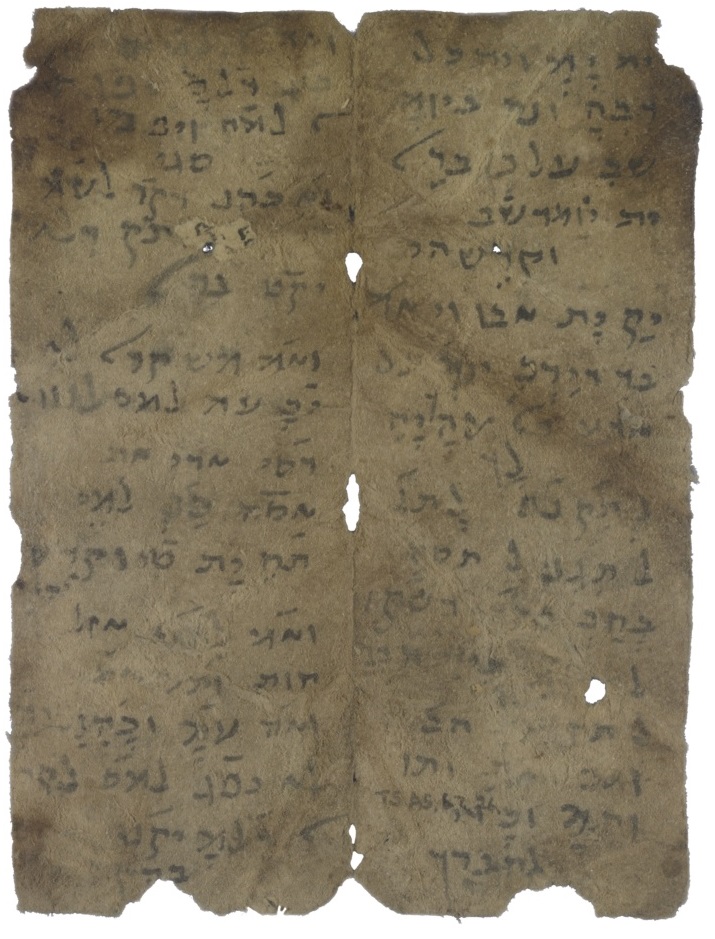
Among the most charming of the dozens of thousands of Bible fragments found in the Cairo Genizah,1 are the hundred or so in which the biblical text is written in some sort of shorthand, or abbreviated, manner.2 At least three different methods of abbreviation are found among these manuscripts. Sometimes, only the opening few words of each verse are written (the ‘Lemma Method’). The great pronouncement of comfort in the opening two verses of Isaiah 40, written in full, appears as:
נַחֲמ֖וּ עַמִּ֑י יֹאמַ֖ר אֱלֹהֵיכֶֽם׃
דַּבְּר֞וּ עַל־לֵ֤ב יְרֽוּשָׁלִַ֙ם֙ וְקִרְא֣וּ אֵלֶ֔יהָ כִּ֤י מָֽלְאָה֙ צְבָאָ֔הּ כִּ֥י נִרְצָ֖ה עֲוֺנָ֑הּ כִּ֤י לָקְחָה֙ מִיַּ֣ד יְהוָ֔ה כִּפְלַ֖יִם בְּכָל־חַטֹּאתֶֽיהָ׃
Using the Lemma Method, these verses could be abbreviated to something like:
נַחֲמ֥וּ נַחֲמ֖וּ׃ דַּבְּר֞וּ עַל־לֵ֤ב
"Comfort, comfort. Speak tenderly”.
Another very common method of abbreviation found in these manuscripts is to reduce each word down to a single letter, or just a few letters (the ‘Serugin’ technique). Sometimes the first letter(s) of each word are chosen, which would reduce the verses above to the following:
נ נ ע י א
ד ע ל י וק א כ מ צ כ נ ע כ ל מי י כ בכ ח
Alternatively, sometimes the accented consonant of each word is written (usually together with the relevant accent). This would reduce our two verses to the following, rather bewildering, array:
מ֥ מ֖ מִּ֑ מַ֖ כֶֽ
ר֞ לֵ֤ לִַ֙ א֣ לֶ֔ כִּ֤ אָ אָ֔ כִּ֥ צָ֖ נָ֑ כִּ֤ חָ יַּ֣ וָ֔ לַ֖ תֶֽ
The first two of these techniques are not unique to Bible manuscripts; they can be found (to a greater or lesser extent) in a very wide array of types of manuscript from the Genizah.3 Back in 1992, Michael Klein published transcriptions of four Targum fragments written in abbreviated form, three from the Taylor-Schechter collection, and one from the Genizah collection at the Jewish Theological Seminary, New York.4 Three of them used the Lemma method of abbreviation, and one used the first-letter-Serugin method.
Several years ago I stumbled across yet another ‘shorthand’ Targum fragment, raising the total number of currently known such manuscripts to five.5 This fragment is described and transcribed below, and its surprising relationship to one of the Taylor-Schechter shorthand Targum fragments is discussed.
Oxford MS heb f. 56/1–12
Of the 130 folios described under classmark 2821, Cowley bundles the first nineteen together under the heading ‘Various fragments.’6 There does seem to be some meaningful interrelationship between these fragments, inasmuch as—in addition to the obvious continuity of content among some of the fragments—some of the less obviously related fragments nonetheless appear to have reused parchment from the same earlier documents. Our particular interest lies in the first twelve folios. Folio 1 is paper; the remainder of the twelve are parchment, though with some lamination of paper over parchment, approximately 19 x 13cm. Many of the parchment folios are second-hand, and contain fragments of earlier texts in Judaeo-Arabic and Arabic, with the new material written around the older texts. Apparently, this was an informal, personal use production.
Oxf MS heb. f. 56/3r7
Even among the first twelve leaves a surprising range of material is represented, the most relevant of which is as follows:
Folio 1r/1v: Exodus 20:12–26 in Hebrew, in abbreviated form (first-letter-Serugin method)
Folio 1v: Calendrical material (continued, non-contiguously, on f. 4r)
Folio 2r: Fragment of Judaeo-Arabic letter, written transversely to the material on the verso
Folio 2v: Tg Onkelos Exodus 19:21–20:5a, in abbreviated form (first-letter-Serugin method)
Folio 3r: Tg Onkelos Exodus 20:5b–12, in abbreviated form (first-letter-Serugin method)
Folio 3v: Tg Onkelos Exodus 20:13–21, in abbreviated form (first-letter-Serugin method). On this leaf, the text up to v. 19a is written on the parchment. However, the lower half of the parchment leaf was already taken up by an earlier text in Arabic. Thus, vv. 19b–21 were written on a new parchment leaf (now f. 6r). At some point, the same user of the manuscript laminated a paper ‘patch’ over the Arabic on the lower half of f. 3v, and (re-)copied vv. 19b–21 onto that paper patch.
Folios 4–5: bifolium, with calendrical material running contiguously from f. 4v to f. 5r
Folio 6r: Tg Onkelos Exodus 20:19b–21, in abbreviated form (first-letter-Serugin method), followed by a selection of Rabbinic calendrical summary statements (לא אד’’ו ראש, etc)
Folios 6v–12r: Passover Haggadah, with Judaeo-Arabic instructions, in partially abbreviated form (first-letter-Serugin method).
Thus, the first twelve folios contain three distinct textual units written in abbreviated form: (1) the Hebrew text of Exodus 20:12–26; (2) Targum Onkelos of Exodus 19:21–20:21; (3) Part of the Passover Haggadah. Interspersed between these texts is calendrical material, and material from the parchment’s original use, before it was commandeered for reuse. The abbreviated texts are all written in the same hand, employ the same distinctive textual and paratextual elements, and show the same method of text-abbreviation. In the images below, note the distinctive inverted tick symbol used to represent the Tetragrammaton, the short, oblique stroke frequently added over abbreviated words, and the particular alef-lamed ligature:
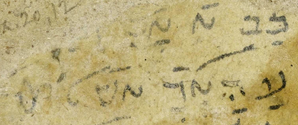
F. 1r: Exodus 20:12 (Hebrew serugin)
כבד את אביך [ואת אמך למען יארכון ימיך] על האדמה אשר ה' ﭏהיך [נתן לך]

F. 3r: Tg Exodus 20:10
שבתא קדם יוי ﭏהך

F. 7v: Passover Haggadah
מה נשתנה הלילה הזה מכל הלילות

F. 8r: Passover Haggadah
[עבדים היינו לפרעה] במצרים ויוציאנו ה' ﭏהינו משם ביד חזקה [ובזרע נטויה]
Already, questions arise: Why are these particular texts brought together in abbreviated fashion? Why does the calendrical material interweave and divide the Hebrew and Aramaic Exodus material? As to the first question: the Hebrew and Targum texts from Exodus are read at Shavuot, so possibly there is a loose ‘festival texts’ link with the Haggadah. The calendrical material—particularly the talmudic simanim—would fit this festival theme, albeit scarcely. As to the current arrangement of the material, and whether the current foliation is original, little can be said: the material is too poorly preserved.
What else can be deduced about the date and Sitz-im-Leben of these fragments? As already mentioned, much of the parchment is second-hand, and preserves parts of earlier documents. At the end of the Haggadah material, on f. 12v, stands a fragment of a Judaeo-Arabic deed concerning property transfer, drawn up in Cairo before Gaon Maṣliaḥ HaKohen.8 This places this earlier document in the first half of the twelfth century.9 Other reused, datable documents in the first 19 folios also come from the first quarter of the twelfth century. Likewise, the calendrical material—clearly written at approximately the same time as the abbreviated texts—offers some help. According to Vidro,10 it is a wide-range calendar, covering the periods 1161/2–1190/1 CE, and 1275/6–1350/1 CE. These dates for the reused material cohere well with the dates for the earlier material, and give a terminus post quem of approximately the final third of the twelfth century for the abbreviated texts.
So far we have simply introduced the abbreviated Targum fragment in its immediate codicological context. Further questions arise when we begin to compare this fragment with the other abbreviated Targum fragments collected, described and transcribed by Klein. In particular: it turns out that the Oxford abbreviated Targum fragment is functionally identical to one of the Cambridge abbreviated Targum fragments: T-S AS 66.14+T-S AS 67.26. Like the Oxford fragment, the Cambridge fragment consists of Targum Onkelos for Exodus 19:21–20:21. It was clearly written by the same hand and employs the same textual and paratextual features. The two texts even share a common haplography. In the snippet below, from the Cambridge fragment, note the same distinctive inverted tick symbol used to represent the Tetragrammaton, the short, oblique stroke frequently added over abbreviated words, and the particular alef-lamed ligature, all of which we have already encountered in the Oxford fragment:
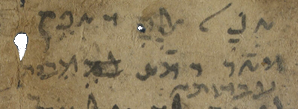
Snippet from T-S AS 67.26, containing the TgO of Exodus 20:2
אְנָא יוי אְלָהָך דְאַפֵיקתָך מארעא דמצרים מִבֵית עַבדוּתָא׃
The line by line comparison of the two texts below shows that the method of abbreviation, typical abbreviations of common words, and sporadic addition of vocalisation signs all confirm that the two texts were indeed written by one and the same person.11
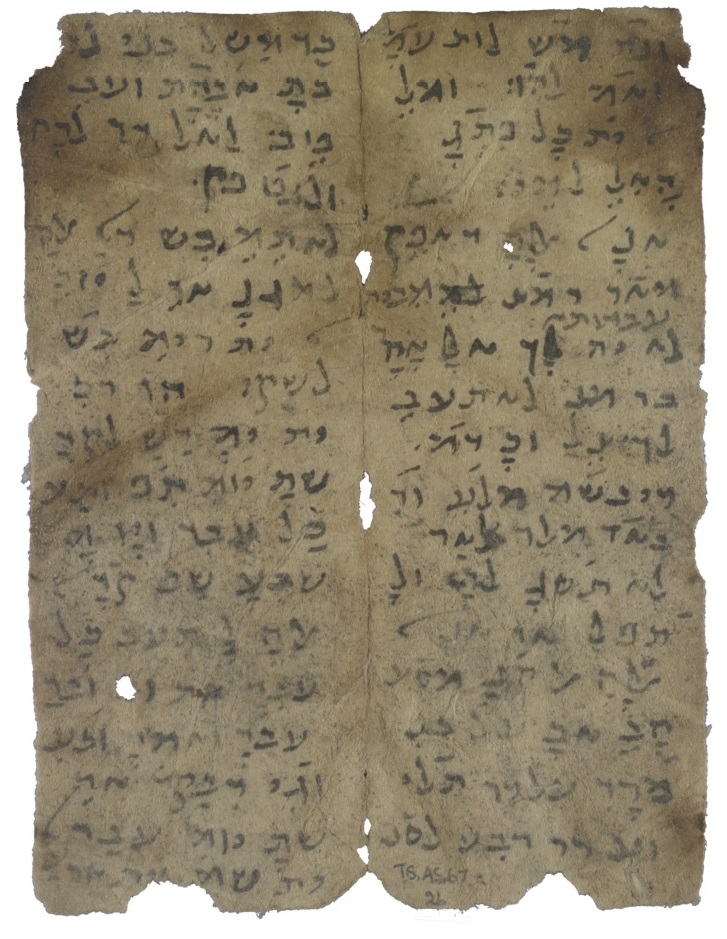
T-S AS 67.26 recto

T-S AS 67.26 verso
Transcription of Oxford MS heb. f. 2v, 3r, 3v alongside T-S AS 66.14+ T-S AS 67.26
In the following transcription, the texts of the Oxford and Cambridge fragments are presented side-by-side, to facilitate comparisons. The text in the right hand column is that of the Oxford fragment. The transcription follows the lineation of this fragment. The middle column contains the text from the Cambridge fragment, although the lineation has been adjusted to match that of the Oxford fragment.12 The left hand column is Sperber's Targum text.
MS heb. f. 56/2v: Abbreviated Targum Onkelos Exodus 19:21–20:5a

MS heb. f. 56/3r: Abbreviated Targum Onkelos Exodus 20:5b–12

MS heb. f. 56/3v: Abbreviated Targum Onkelos Exodus 20:13–21

Analysis
Vocalisation
Both the Oxford and Cambridge manuscripts are partially vocalised, using Tiberian signs. Shewa is rarely used; neither dagesh forte nor dagesh lene are indicated at all.
Qibbuṣ is used only four times (twice in the Oxford fragment: both at 3v, line 1; twice in the Cambridge fragment: 3r, line 15; 3v, line 6).13 In each case it occurs on the final written syllable, and serves as a cipher for a full shureq vowel. This technique of using the qibbuṣ symbol to obviate the need to extend the consonantal text by the addition of the vav mater lectionis, is also employed on other shorthand fragments from the Genizah (e.g. T-S A43.3). In all three occurrences, the sign is written ‘backwards’—further confirmation that the same hand (apparently not belonging to a professional copyist of biblical texts) stands behind both texts:14
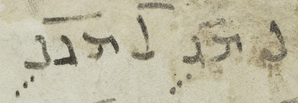
Oxford MS heb. f. 56/3v: Tg Exodus 20:14–15
לָא תְגוּף לָא תִגנוּב

Cambridge T-S AS 66.14r: Tg Exodus 20:18
וְקָמוּ מֵרַחִיק׃
Both the Oxford and Cambridge fragments sometimes use the qameṣ sign where ḥolem would be expected. For example, in the Oxford fragment, expected כֹּל appears as כָ (see 2v, line 9; 3r, line 12; 3v, line 4). The phenomenon is even more pronounced in the Cambridge fragment, as the following, non-exhaustive, examples show:
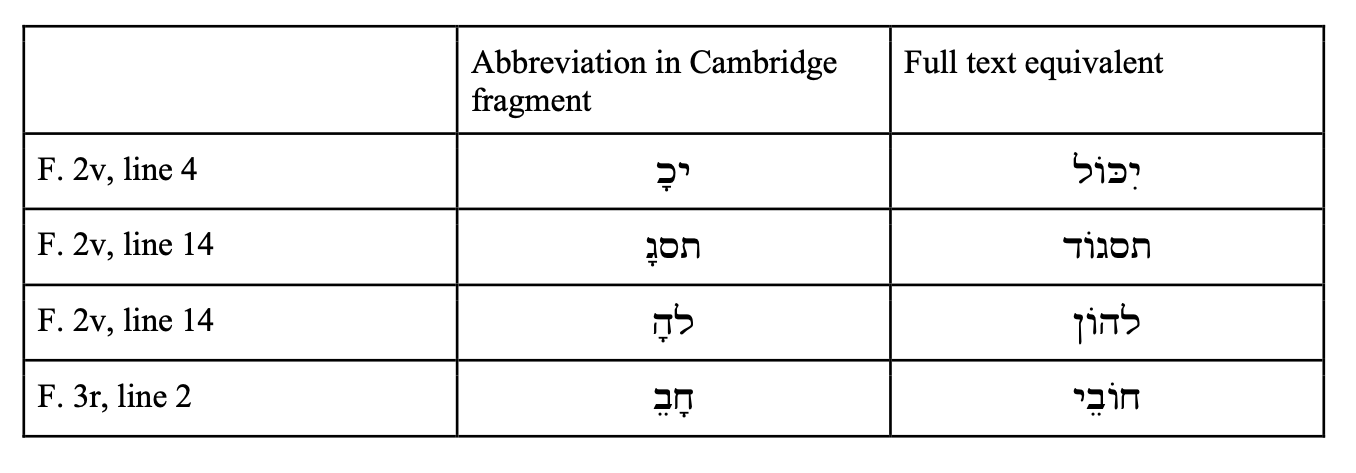
The same phenomenon can be found in common Bibles from the Genizah collection (e.g. T-S A24.82).15 Given the frequent occurrence of the qameṣ/ḥolem interchange in lexemes such as כל, it seems likely to me that the phenomenon here is simply an extension of the use of the qameṣ grapheme, rather than representing a different pronunciation.16
In fact, the phenomenon seems to have extended further. Several times (if we are reading the fragments correctly, which is far from certain in several places), a pataḥ seems to have been used instead of a ḥolem. See, for example:

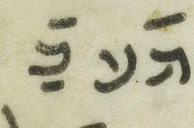
Oxf., f. 3r, line 8. Example of pataḥ used instead of ḥolem.
Fassberg finds this phenomenon in several of the Palestinian Targum fragments he examined, and suggests, as adumbrated above, that it is best understood as an extension of the use of the /a/ graphemes, under the influence of the bivalent use of the qameṣ grapheme to represent both /o/ and /a/.17
Consonantal Text
Comparing the Oxford and Cambridge texts, one is struck by just how often the two texts abbreviate a given word in precisely the same manner—i.e. they agree completely in how much of each word is written. On the other hand, it is also clear that there is no slavish adherence: one text may represent a given word with a single letter, while the other version uses two or three letters. Likewise, though there is considerable agreement in which words are vocalised, and how, there is also substantial freedom in this regard. This coheres well with the informal, occasional nature of the productions.
Collating the Oxford and Cambridge fragments against Sperber’s text reveals only four occurrences of consonantal deviation.
Folio 2v, line 3

The Oxford fragment omits any abbreviation of the form יתקדשון.
Folio 2v, line 14:

Both the Oxford and Cambridge fragments omit abbreviations for the phrase ודבמיא מלרע, apparently a classic case of homoioteleuton.
Folio 3r, line 3:

In the Oxford fragment, the word משלמין is unusually abbreviated as משמ.
Folio 3r, line 10:

Both the Oxford and Cambridge fragments omit the waw prefix on ועבדך.
The two consonantal deviations shared by both the Oxford and Cambridge fragments clearly point to some sort of genetic relationship between the two fragments. Either one fragment was copied from the other, or both were copied from a shared Vorlage. Frustratingly, the informal nature of the texts means that one could easily fit the available data to any of the three formal possibilities (A copied from B; B copied from A; A and B copied from C).
What I think we can say with a degree of certainty is that the Cambridge recension is better suited to serving as an aide-mémoire for the meturgeman in the synagogue. The dimensions of the Cambridge fragment (17 x 6 cm) would render easier its “inconspicuous use in the synagogue,”18 than the Oxford fragment (19 x 13 cm). In addition, many of the verses in the Cambridge fragment begin on a new line (and the resulting easing of space restrictions mean that often the final words of the verse are written in full). Given that the meturgeman was required to translate verse by verse (m.Meg 4:4), this layout would have rendered the Cambridge fragment an easier tool for the job that the Oxford fragment, whose text is laid out continuously.19
There is, perhaps, further justification for positing that the creator of these texts was indeed aiming at producing an aide-mémoire for inconspicuous use in the synagogue. Recall that on f. 3v, the text of Exodus 20 up to v. 19a is written on the parchment. However, the lower half of the parchment leaf was already taken up by an earlier text in Arabic. Thus, vv. 19b–21 were written on a new parchment leaf (now f. 6r). Nonetheless, at some point, the same user of the manuscript laminated a paper ‘patch’ over the Arabic on the lower half of f. 3v, and (re-)copied vv. 19b–21 onto that paper patch. What motivated the user to perform this patch-up job? Plausibly, they were concerned to keep the text confined to just two leaves because they intended to use those leaves in reciting the Targum in the synagogue service.
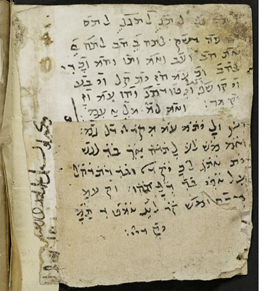
Oxf. MS heb. f. 56/3v, showing the paper lamination over the earlier Arabic text
As usual, the Genizah documents afford us a strikingly clear snapshot of the distant past, while at the same time leaving us bewildered by many questions. In these Oxford and Cambridge abbreviated texts we have met someone, perhaps during the time of Maimonides himself, with an interest in the biblical and targum texts, as well as the Haggadah liturgy, and the Hebrew calendar. This person was sufficiently well versed in writing as to be able to employ an easy semi-cursive hand. Yet, on the other hand, they were ill-versed in the formal elements of the vocalisation signs, to the extent that they wrote their qibbuṣ backwards. Did this person, perhaps, have the honour of serving as meturgeman one Shavuot? An honour they took seriously enough to write out the targum reading multiple times, in abbreviated form, as preparation?
Dr Kim Phillips
Research fellow, Institute for Hebrew Bible Manuscript Research (ihbmr.com) and Research Associate, Taylor-Schechter Genizah Research Unit, Cambridge University Library
This article first appeared as the Fragment of the Month for January 2024. If you enjoyed reading it, other Fragments of the Month can be found here.
Footnotes
1 With many thanks to my colleagues in the Taylor-Schechter Genizah Research Unit for their helpful comments and observations, and particularly to Sarah Sykes, who transformed the Word document of this articlette into its current web format, at great risk to her sanity.
2 Thanks to the generosity of the Rothschild Foundation, I had the privilege of studying these manuscripts in some detail. See Kim Phillips, “Abbreviated Bible Manuscripts in the Cairo Genizah: An Initial Survey of Form and Function,” Textus 31 (2022): 69–120. See, too, Kim Phillips, “A Shorthand Psalter: T-S A43.8,” Fragment of the Month, May 2020, https://www.lib.cam.ac.uk/collections/departments/taylor-schechter-geniz....
3 See Phillips, “Abbreviated Bible Manuscripts” for this broader context.
4 Michael Klein, “Serugin (Shorthand) of Onqelos from the Cairo Genizah,” Maarav 8 (1992): 275–87.
5 That is to say: I read Cowley’s description of the fragment. Nothing more impressive than that.
6 Adolf Neubauer and Arthur Ernest Cowley, Catalogue of the Hebrew Manuscripts in the Bodleian Library and in the College Libraries of Oxford: Including MSS in Other Languages, Which Are Written with Hebrew Characters, or Relating to the Hebrew Language or Literature, and a Few Samaritan MSS, 3 vols., Catalogi Codd. Mss. Bibliothecae Bodleianae 12 (Oxford: Clarendon Press, 1886), cols 236–242.
7 With thanks to the Bodleian Library.
8 Neubauer-Cowley, Catalogue, col. 236.
9 Jacob Mann, The Jews in Egypt and in Palestine Under the Fatimid Caliphs, vol. 1 (Oxford: Oxford University Press, 1920), 196–197.
10 Nadia Vidro, private communication, 8/1/2024. I am very grateful to Dr Vidro for kindly sharing her expertise in this way. Dr Vidro also commented that the calendrical material contains mistakes consistent with someone copying the material without fully understanding the contents. It seems we are dealing more with a casual calendarist than a hardened horologist.
11 When publishing the Cambridge fragment, Klein enlisted the expertise of none other than Malachi Beit-Arié for assistance with the dating of the fragment. Beit-Arié hesitantly posited the twelfth century for fragments T-S AS 66.14 and T-S AS 67.26, which coheres well with the terminus a quo of the Oxford abbreviated texts. See Klein, “Serugin,” 278, 280.
12 I used Klein’s transcription of the Cambridge fragment as a basis for my own. However, since Klein did not include vocalisation, it was necessary to collate the Cambridge fragment afresh. There are a few places where my reading of the consonantal text differs from those of Klein. For the precise lineation and pagination of the Cambridge fragment, see Klein, “Serugin,” 280–284.
13 When citing the Cambridge fragment, the reference is to the transcription above. Thus 3v line 6 actually refers to the Oxford fragment, but since the text of the Cambridge fragment has been aligned with the Oxford fragment, this method of reference is still the most straightforward.
14 This same phenomenon appears in other non-professional, user-produced Bible fragments from the Genizah. See Benjamin Outhwaite, “The Tiberian Tradition in Common Bibles from the Cairo Genizah,” in Studies in Semitic Vocalisation and Reading Traditions, ed. Aaron Hornkohl and Geoffrey Khan, Cambridge Semitic Languages and Cultures (Cambridge: Open Book Publishers, 2020), 405–66.
15 See Estara Arrant, “A Codicological and Linguistic Typology of Common Torah Codices from the Cairo Genizah” (University of Cambridge, Ph.D., 2021), 412.
16 One reviewer helpfully raised the possibility that here, too, the extension of the use of the qameṣ was motivated by the desire to abbreviate: just as qibbuṣ was used as a cipher for shureq, so too qameṣ qatan was perhaps used purely as a cipher for ḥolem vav.
17 Steven Fassberg, A Grammar of the Palestinian Targum Fragments from the Cairo Genizah (Atlanta, Georgia: Scholars Press, 1990), 41.
18 Klein, “Serugin,” 277.
19 Amram Gaon affirms that the Torah reading had to be translated into Aramaic one verse at a time, so it appears that this particular stipulation of the Mishnah was still practised in the mediaeval period. See Daniel Goldschmidt, ed., Seder Rav Amram Gaon (Jerusalem: Mosad HaRav Kook, 1971), 76–77.

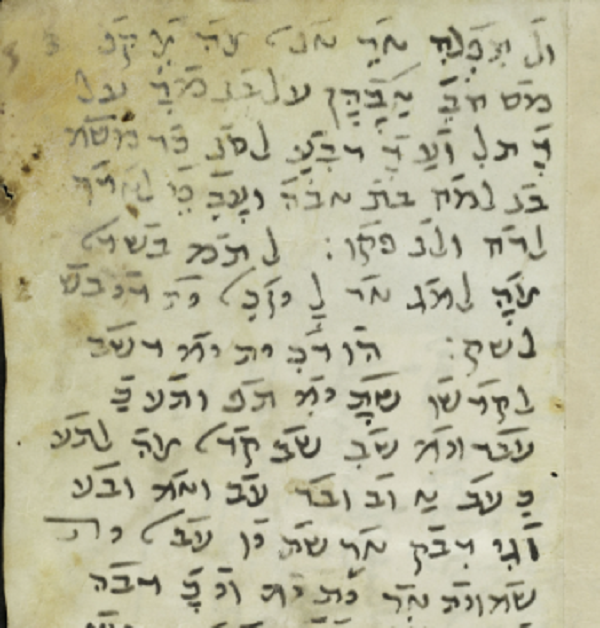
Add new comment